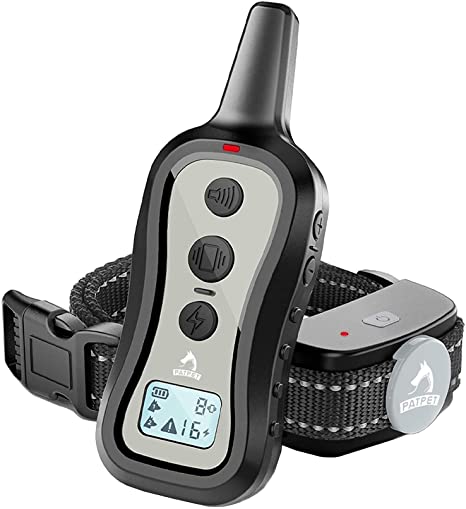Owner’s Manual



PATPET Remote Trainig Collar
PLEASE READ THIS ENTIRE GUIDE BEFORE BEGINNING


Important Safety Information
![]()
![]()
![]()
![]()
![]()
![]()
![]()
![]()
CAUTION: Risk of skin damage. Please read and follow N the instructions in this manual. Proper fit of the collar is important. A collar worn for too long or made too tight on the pet’s neck may cause skin damage. Ranging from redness to pressure ulcers; this condition is commonly known as bed sores.
- Avoid leaving the collar on the dog for more than 12 hours per day.
- When possible reposition the collar on the pet’s neck every 1 to 2 hours.
- Check the fit to prevent excessive pressure; follow the instructions in this manual.
- Never connect a lead to the electronic collar; it will cause excessive pressure on the contacts.
- When using a separate collar for a lead, don’t put pressure on the electronic collar.
- Wash the dog’s neck area and the contacts of the collar weekly with a damp cloth.
- If a rash or sore is found, discontinue use of the collar until the skin has healed.
- If the condition persists beyond 48 hours, see your veterinarian.
These steps will help keep your pet safe and comfortable. Millions of pets are comfortable while they wear stainless steel contacts. Some pets are sensitive to contact pressure. You may find after some time that your pet is very tolerant of the collar. If so, you may relax some of these precautions. It is important to continue daily checks of the contact area. If redness or sores are found, discontinue use until the skin has fully healed.
Components
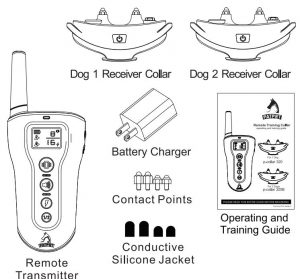

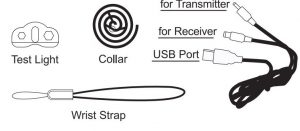

Other Items You May Need
- Screwdriver (the Test Light can be used as a screwdriver)
- Scissors
- Lighter
Main Features
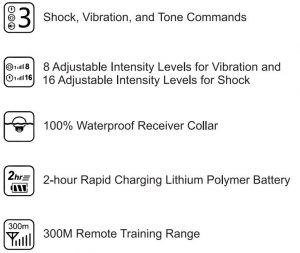



Overview
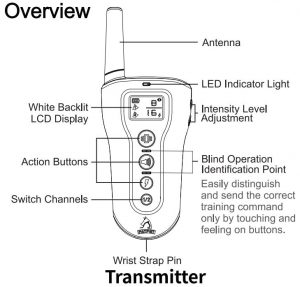

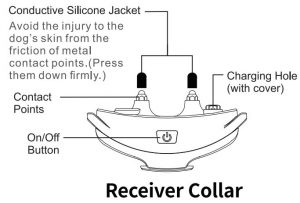

Prepare the Receiver
Install the Contact Points & Conductive Silicone Jacket
- Select the correct Contact Points and Conductive Silicone Jacket length for your dog’s coat type:• For dogs with thicker coats, Use 2pcs longer Contact Points and Conductive Silicones Jacket.• For dogs with shorter coats, Use 2pcs shorter Contact Points and Conductive Silicones Jacket.Note: Don’t install the Metal Contact Points when shock function is not be used.
- Insert the Contact Points into the ports of the collar, rotate clockwise to tighten them(1A).
- Install the Conductive Silicone Jacket onto the Contact Points to make it softer, which will benefit dog’s skin (1 B).
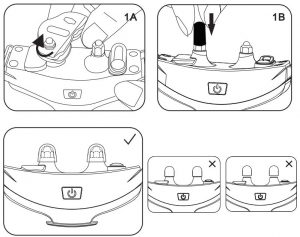

Operating Guide
STEP 1 : How to tum the p-collar 320 on/off
To tum the Transmitter on


To turn the Transmitter offTransmitter has no POWER ON/OFF button. so that there is an immediate correction when pressing the Transmitter to stop a dog’s misbehavior. lf the transmitter needed to be turned on first, the best training correction could be missed .
To turn the Receiver Collar onPress ![]()
![]()
To him the Receiver Collar off
- Press and hold the On/Off Button until the Red LED light shuts off.(This takes approximately three seconds.)
- Release the on Off Button.Note: To extend the life of the batteries, please tum the Receiver Collar off when it is not in use.
Step 2: How the Transmitter buttons work


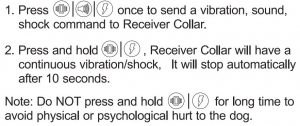

Dog 1/2 Button


Step 3: How to use the collar correctly
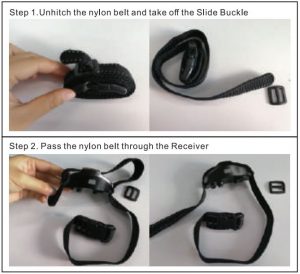

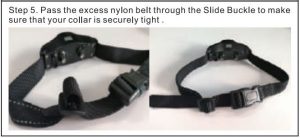

Step 4: Fit the Training Collar
Important: The proper fit and placement of your training collar is important for affective operation. The contact points must have directly touched your dog’s skin on the underside of his neck.
- Start with the collar turned off and your dog standing comfortably, not sitting(A).
- Put the training collar on your pet directly under your dog’s chin. Center the contact points underneath your dog’s neck, and touch the skin (B).
NOTE: It’s sometimes necessary to trim the hair around the contact points to make sure that contact is consistent. We’ve also included longer contact points.
CAUTION
Do not shave the pet’s neck as this may increase the risk of skin irritation. The training collar should not be worn for more than 12 hours out of every 24-hour period. Leaving the training collar on too long could lead to skin irritation. Remove the collar when you’re not training your dog.


Step 5: How to find the best vibration/shock level
The unit comes with Up and Down buttons to control the Vibration/Shock Level, with Level 1 being the lowest level for Both Vibration and Shock, Level 8 being the highest for Vibration and Level 16 being the highest for Shock.
The level al Vibration/Shock best suited for your dog depends on your dog’s temperament and threshold for Vibration/Shock. Always start at the lowest level and work your way up.
The appropriate level can be found when the dog responds to the Vibration/Shock with a mild reaction, such as a tensing of the neck muscles. The Vibration/Shock Level may vary depending on the training situation. When highly distracted, dogs will require a higher level al Vibration/Shock.
Step 6: How to switch between vibration level and shock level


Step 7: To maximize the distance
The unit has a 300 – meter range. The range may vary depending on the way of the Transmitter being held. Hold the Transmitter away from your body to receive the greatest range. For maximum signal strength, keep the device properly charged.
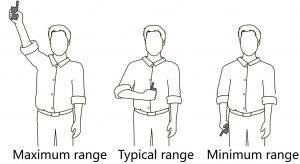

*Avoid touching the antenna, as the range may decrease substantially.
Step 8: The LCD & LED indicator
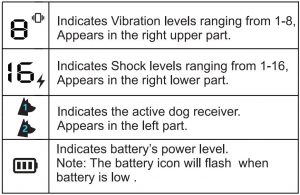

Transmitter LED Indicator Light – Function and Response
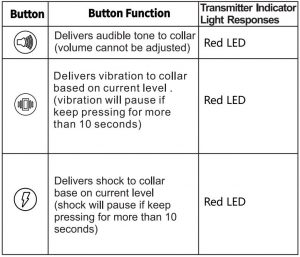

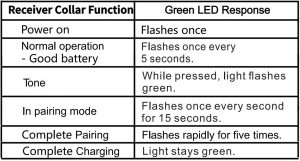

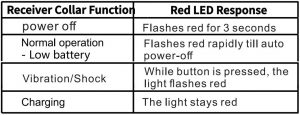

Step 9: Charging the unit
The unit uses Lithium-Polymer batteries.
- Charge the unit before using the unit for the first time.
- Do not charge the unit near any flammable substance.
- Charge the unit full firstly ,if it sat idle for more than 3 months .
Recharge the unit if:The indicator light on the collar flashes red rapidly .The battery Icon on 1he Transmitter LCD shows Just 1 bar.
The indicator light on the Transmitter or Receiver will not come on.the indicator light on the Transmitter or Receiver doesn’t come on momentarily when any button is pushed.
Battery Charging ProcedureNOTE: The unit had a partial charge when it left our facility. Upon receiving the collar, be sure to give it a 4-hour initial charge before the first use.
- Plug the adapter into a standard wall outlet.
- Lift the rubber cover of the charging hole ,which is designed to keep the water out of the receiver .
- Plug the chargers into the Transmitter and Receiver as shown below .
- Connect the USB port to the Charging Adapter.
- Charge the unit for 4 hours for the first charge. Recharges take only 2-3 hours.
Note:
- While Transmitter is charging ,the battery icon on the screen will scroll and the indicator light will be red . When fully charged , the light will flash red.
- While Receiver is charging ,the indicator will also be red, but when finished ,it will become green.
- When charging is completed, remove the connector.
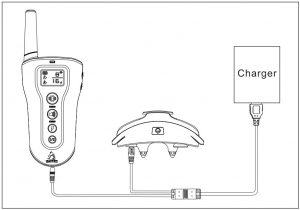

Step 10: How to pair the remote Transmitter & Receiver
If your Receiver does not beep when you press the Tone Button of the Remote, or if you find the Receiver isn’t responsive to the Remote Transmitter, follow these steps to pair:
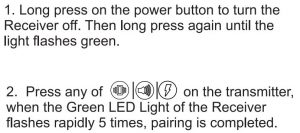

Two Dog SystemNOTE: If you wish to add another Receiver Collar to the train ing system, please buy the same model receiver.
Remote Transmitter
- Switch Dog 1 to Dog 2 by short pressing the button “1 /2”.
- Turn on the Receiver Collar for Dog 2, then repeat the pairing steps above.
- If Dog 2 Receiver does not respond . Pairing may be need ad. Repeal steps in Pair the Remote an d the Receiver above.
Step 11: How to use the test light
- Turn the Receiver Collar on.
- Hold the Test Light Contacts to the Contact Points, guide as shown below.
- Press the SHOCK Button on the Remote Transmitter.
- The Test Light will flash. Note: The higher shock level is , the brighter of the Test Light will flash.
- Turn the Receiver Collar off.
Note:
- Save the Test Light for future testing.
- When testing ,please make sure the collar has been paired and fully charged.
- If Test Light doesn’t flash at any level, contact us for Customer Service. Contact information is on the last page.
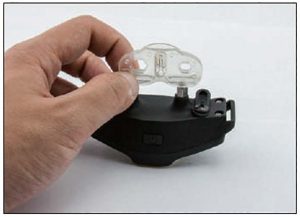

Training Guide
General Tips
- Pets should be at least 6 months old before using the Training Collar.
- Be sure to let your pet associate the collar with happy things.
- Using a treat and a praise AS SOON AS the dog obeys the command, as positive training is better than negative training. Adding the treat helps reinforce the good behavior. The object the collar is to NOT need to use it.
- It’s NOT A TOY I Only responsible family menbers should use the Training Collar.
- Correct one misbehavior or teach one obedience com mend at a ti me so that your pet is not confused .
- If your pet reacts to the collar by hiding or acting fearfully ,check the settings as they may be too high for your pet’s needs.
- It is recommended to train one dog at a time in a distraction-free environment, both to increase efficiency and to avoid temptation or distraction from other dogs.
![]()
![]()
![]()
![]()
Never use the Remote Training Collar to correct or eliminate any form of aggressive behavior. We recommend you to consult your local veterinarian or professional trainer to determine if your pet might be aggressive. See page 3 for more information.
Frequently Asked Questions
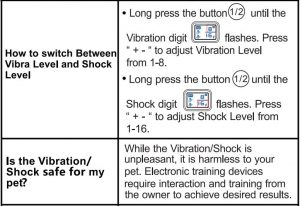

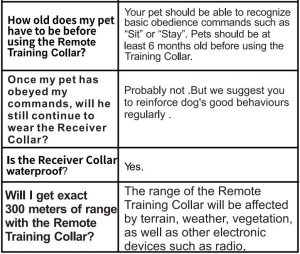

Troubleshooting
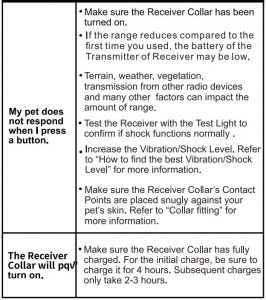



Warranty and repair information
1-Year WarrantyThe original purchaser for this unit is provided with 1-YEAR WARRANTY.
The warranty begins from the dale of purchase. For the first year, coverage is for both Parts and Labor on warranty repair services, but the return postage is for the buyer’s account . Accessories such as chargers, splitter cables, antennas, straps, and batteries are covered for the first year only. When the warranty expires, customers will need parts and repairs al their own expense.
To Qualify for the warrantyAll products must provide a proof of purchase in order to initiate repair work under warranty. We strongly recommend keeping the original receipt. If the proof of purchase is not available, we will estimate the age of the unit by the S/N number. but it will be the only method th at we judge your order time.
Not Covered Under WarrantyWe DO NOT offer warranty for products that have been bought secondhand or as a resold product.
Issues of replacement and refunds, if units are kept less than 30 days from an authorized dealer must be addressed to the dealer directly. If more than 30 days, please send the units to us for after-sale.
Manual damage or loss is not covered by the warranty.
Any water damage on the Water Resistant Transmitters and the Water Resistant Receivers of our product series will not be covered. All replacement costs for either the transmitter or receiver will be the owner’s responsibility.
The warranty is void if the unit has been altered or an unauthorized person who attempting lo repair work has damaged the unit.
Replacement of batteries is not recommend during the warranty period. If the customer chooses to replace the batteries, any damage to the unit during the change-out by the owner will make the warranty void. We reserve the right lo retain and discard any parts or accessories that have been damaged upon repairing.
Procedure for Repair Work
If the unit is malfunctioning, please refer to the “Troubleshooting Guide” in the Operating and Training Guide before sending it back for Service. The cost of shipping products under warranty is the customer’s responsibility. We are not responsible for units damaged or lost in transition. We are not responsible for the loss during training while the unit is under repairing. We do not provide renting units or any form of compensation during repairing. A copy of the sales receipt showing the purchase date may be required before warranty work is initiated. Please include a brief outline of the problem and include your name, address, city/state/zip code, daytime phone number, evening phone number, and email address.
Compliance
FCC – USA
This device complies with part 15 of the FCC Rules. Operation is subject to the following two conditions: (1) This device may not cause harmful interference. (2) This device must accept any interference received, including interference that may cause undesired operation.
CAUTION: Modification or changes to this equipment not expressly approved by Patpet Technology Co., Ltd may void the user’s authority to operate the equipment.
NOTE: This equipment has been tested and found to comply with the limits for a Class B digital device, pursuant to part 15 of the FCC Rules. These limits are designed to provide reasonable protection against harmful interference in a residential Installation. This equipment generates. uses, and can radiate radio frequency energy and, if not installed and used in accordance with the instructions, may cause harmful interference to radio communications. However, there is no guarantee that Interference will not occur In a specific installation. If interference does occur to radio or television reception, which can be determined by turning the equipment off and on, the user is encouraged to try to correct the Interference by one or more of the following measures:
- Reorient or relocate the receiving antenna.
- Increase the separation between the equipment and the receiver.
- Connect the equipment to an outlet on a circuit different from that to which the receiver is connected.
- Consult customer care, the dealer, or an experienced radio/ TV technician for help.


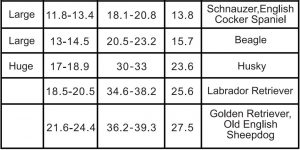

Reference Weight for Dogs
Large Dog (Body height above 24 Inches, Weight above BB lbs) Medium Dog (Height 16-24 inches, Weight 24.2-66 lbs) Small Dog (Height 10-18 inches, Weight 8.8-22 lbs)Mini Dog (Height under 1O inches, Weight under 8.8 lbs)



Shenzhen Patpet Technology Co.,Ltd
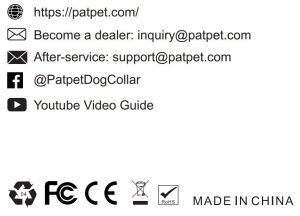

References
[xyz-ips snippet=”download-snippet”]

